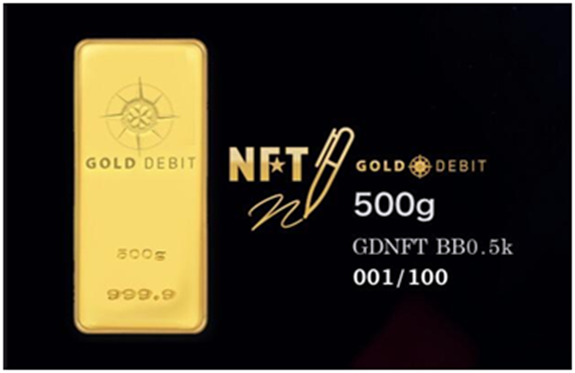16/08/2021 XRoad Is Changing the Cloud Computing Industry and Launching Innovative NFT Product, GoldDebit by XRI
An innovative NFT product, named GoldDebit, by XRI(XRoad Initiative) is upcoming.
What is GoldDebit NFT?
GoldDebit NFT is a new type of NFT product of gold bullion. In addition to the asset value of the gold bullion, GoldDebit NFT has a highly entertaining element.
Especially the GoldDebitwith autographs by famous people(first they are teaming up with the sports industry) has a huge appeal not only for the fans who wrote that autograph but also for millions of people around the world because the autographed gold bullion can be a product which people can keep as an asset value.

Development Outlook
This GoldDebit is providing autographs of famous people. Furthermore, XRI is developing a virtual town where people can socialize with famous people such as athletes, in the future.
– Developing a new NFT product, GoldDebit with a trading company.
– Introducing a point system with the GoldDebit for the customers who buy the NFT product.
– Realizing the international money transfer with GDP(Gold Debit Point)
– Building a microfinance model to utilize GoldDebit
– etc…
This new project with blockchain technology and NFT services seems to show us very fast growth in their industry. They expand their services in new platforms, such as the new NFT marketplace, with NFT products including highly entertaining elements, so we should stay tuned for things to come.
Not only this XRoad Is Changing The Cloud Computing Industry.
The underpinnings of digital business are embodied in Cloud Computing. Over the last 10 years, this industry has developed at a breakneck speed. Worldwide end-user spending on public cloud services is forecast to grow 23.1% in 2021 to total $332.3 billion, up from $270 billion in 2020, according to the latest forecast from Gartner, Inc. We are seeing more and more ways to connect and collaborate, moving to the cloud.
The increased volume of work done by global businesses and number of games on the Internet, increased consumer demand for bandwidth and content, global growth in the number of smartphones, the rapid development of web and mobile applications, and high costs of managing developers on a local server are all contributing to this accelerated growth.
Although the cloud computing business started on centralized servers with the likes of Amazon Web Services (AWS), Google Cloud, Microsoft Azure, and Alibaba Cloud dominating the centralized cloud computing space. With the advent of blockchain technology, most companies are getting more inclined to decentralized computing infrastructure due to the numerous advantages it offers.
One of the major setbacks of centralized Cloud Computing is the lack of dogged security architecture and the reliance on centralized servers. The implication, however, is that a single point of failure of the server will rub off on the entire network thereby rendering it offline or out of sync, XRoad, a blockchain-powered cloud computing fixes this.
XRI, abbreviated for X Road Initiative, was listed on Coineal on July 23rd. Companies all around the world have learned that addressing the needs of digital business infrastructure necessitates a decentralized strategy. The cloud must grow into a decentralized architecture for better access, flexibility, efficiency, and security.
XRoad Delivers An Unmatched Decentralized Cloud Computing System
XRoad intends to deliver decentralized infrastructure to individual Internet users to act as the nexus between blockchain technology and the world’s data. XRoad is assembling Oracle, a decentralized cloud computing system for user-powered interoperability between the off-chain world and smart contracts, as well as for individual data self-sovereignty. XRoad is on a mission to bring enterprise solutions to the data market and also solve many of the impending challenges that have eroded the industry.
Decentralized storage (XRDS) offered by XRoad is the product of a multi-cloud decentralized data management philosophy and individual data sovereignty. XRDS provides cost-effective solutions to problems that centralized storage systems cannot address.
Due to a decentralized approach to data management provided by blockchain technology, individuals from all over the world may participate in the ongoing operation on XRoad to store, secure, verify, and authenticate individual data in a manner that centralized storage solutions cannot handle.
In XRoad, data is distributed over a whole network, making it very difficult to attack or censor the network. Furthermore, effective storage space use within a borderless and dispersed network saves money at a time when data storage prices are either rising or becoming more difficult to grasp.
XRoad allows multiple copies of data to be safely stored on separate nodes within a network, which is important in the case of data backup. This is so that consumers and/or enterprises may have the uptime and reliability that centralized storage cannot offer.
Developers on the XRoad platform will be able to utilize common libraries to make it easier to create blockchain solutions without having to learn a new programming language. Users will get an encrypted drive and a global login that doesn’t require passwords, allowing them to seamlessly move their data to whatever program they choose.
The Future Of Cloud Computing Is Right Here With Us
The next step in guaranteeing information security is unquestionably blockchain, and XRoad will be leading this innovation. Data on XRoad is stored on many nodes all around the world and has no single point of failure. This overcomes the problem of data security in a variety of unforeseen situations. With XRoad, only those with a matching key to access encrypted data can control and access files posted to the blockchain.
Existing Cloud Computing initiatives have some flaws, however, state-of-the-art security networks like XRoad Network provide safe cloud computing at a tenfold lower cost than the existing vendors on the market. The future looks bright for the XRoad initiative as strategic partners have rallied behind the project.
 (0)
(0)
 (0)
(0)
